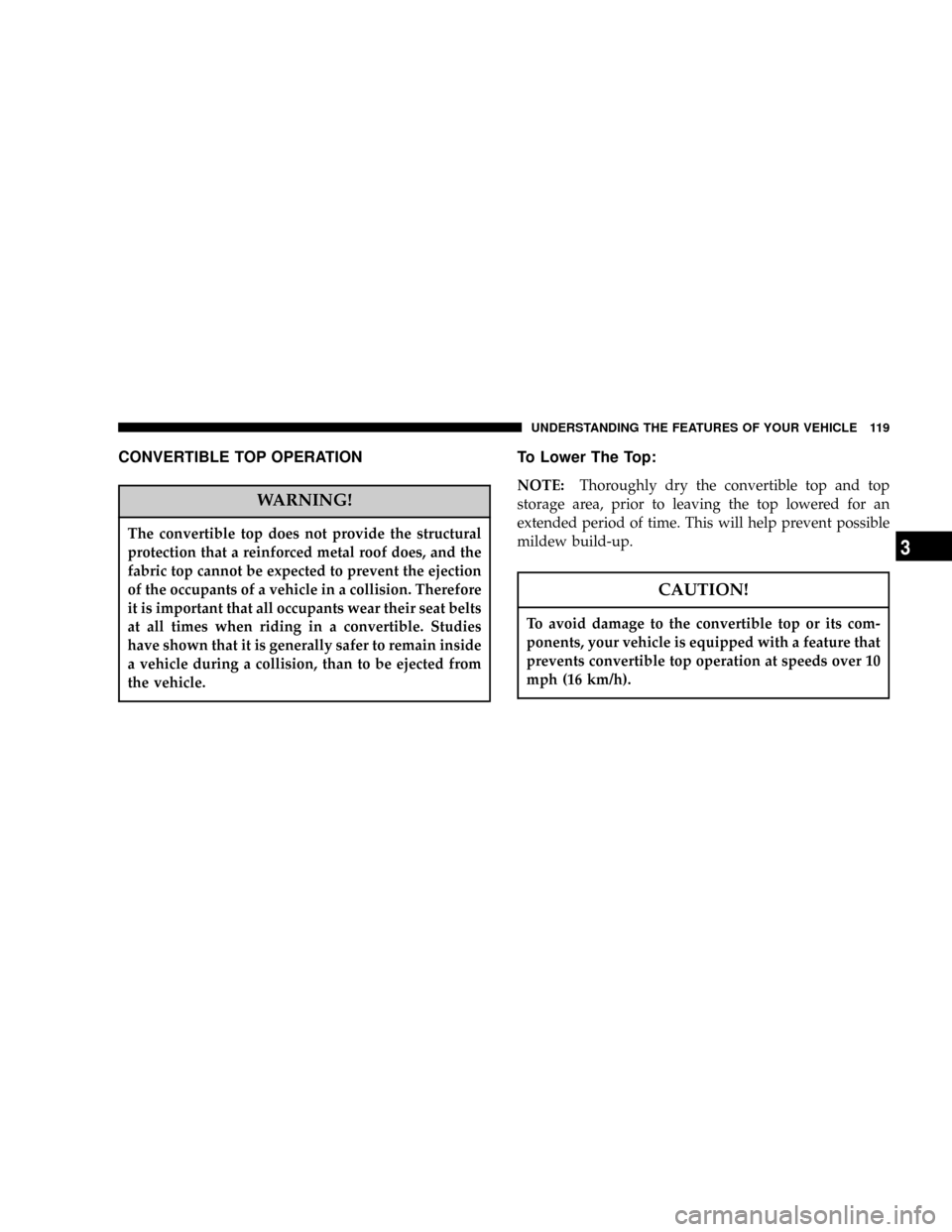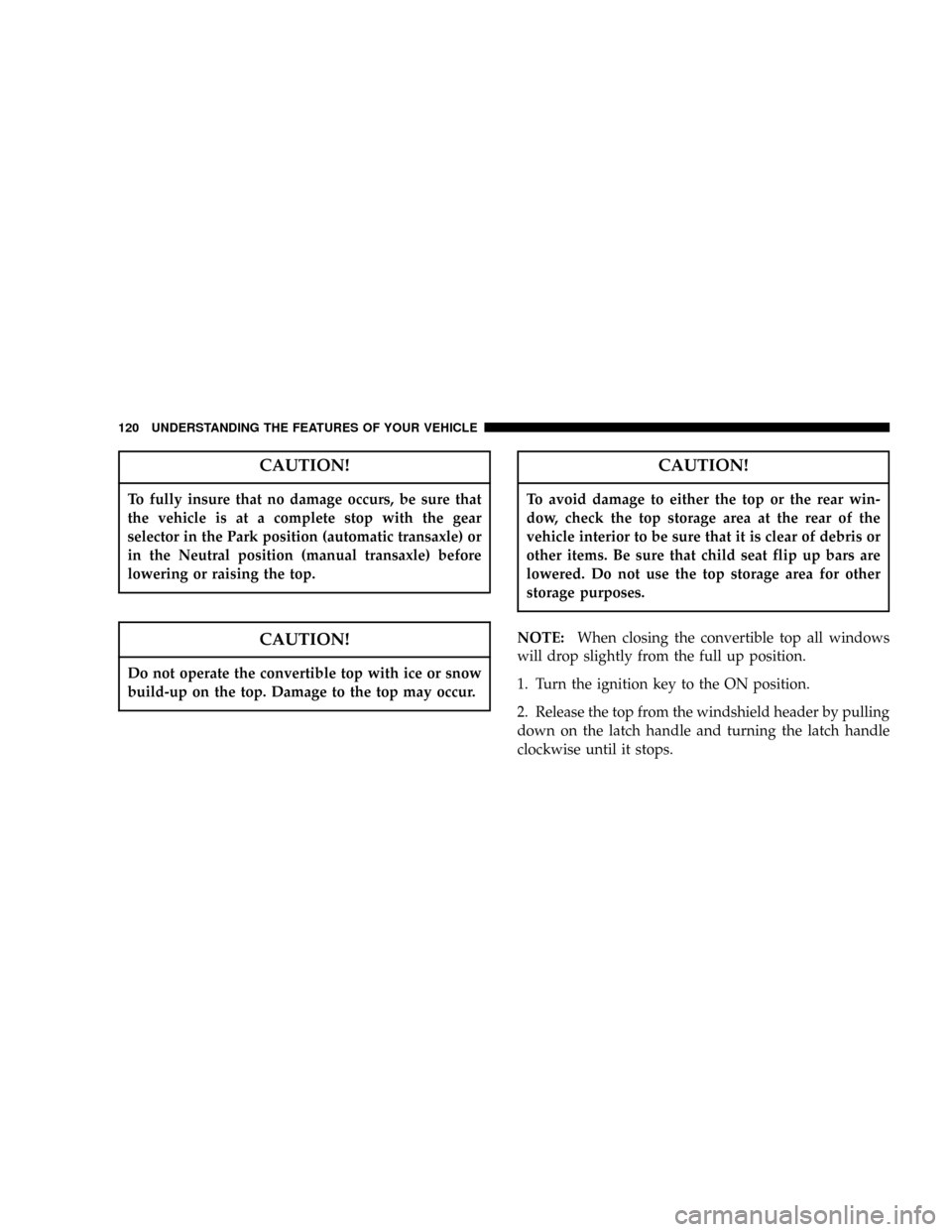CHRYSLER PT CRUISER 2007 1.G Owners Manual
Manufacturer: CHRYSLER, Model Year: 2007, Model line: PT CRUISER, Model: CHRYSLER PT CRUISER 2007 1.GPages: 467, PDF Size: 7.57 MB
Page 111 of 467

Not all child restraint systems will be installed as we
have described here. Again, carefully follow the instruc-
tions that come with the child restraint system.
NOTE:If your child restraint seat is not LATCH com-
patible, install the restraint using the vehicle seat belts.
WARNING!
An incorrectly anchored tether strap could lead to
increased head motion and possible injury to the
child. Use only the anchor position directly behind
the child seat to secure a child restraint top tether
strap.
Children Too Large For Booster Seats
Children who are large enough to wear the shoulder belt
comfortably, and whose legs are long enough to bend
over the front of the seat when their back is against the
seat back, should use the lap/shoulder belt in a rear seat.
²Make sure that the child is upright in the seat.
²The lap portion should be low on the hips and as snug
as possible.
Tether Strap Mounting
THINGS TO KNOW BEFORE STARTING YOUR VEHICLE 111
2
Page 112 of 467

²Check belt fit periodically. A child's squirming or
slouching can move the belt out of position.
²If the shoulder belt contacts the face or neck, move the
child closer to the center of the vehicle. Never allow a
child to put the shoulder belt under an arm or behind
their back.
Transporting Pets
Airbags deploying in the front seat could harm your pet.
An unrestrained pet will be thrown about and possibly
injured, or injure a passenger during panic braking or in
a collision.
Pets should be restrained in the rear seat in pet harnesses
or pet carriers that are secured by seat belts.
ENGINE BREAK-IN RECOMMENDATIONS
A long break-in period is not required for the engine in
your new vehicle.
Drive moderately during the first 300 miles (500 km).
After the initial 60 miles (100 km), speeds up to 50 or 55
mph (80 or 90 km/h) are desirable.
While cruising, brief full-throttle acceleration, within the
limits of local traffic laws, contributes to a good break-in.
Wide open throttle acceleration in low gear can be
detrimental and should be avoided.
The engine oil installed in the engine at the factory is a
high quality energy conserving type lubricant. Oil
changes should be consistent with anticipated climate
conditions under which vehicle operations will occur.
The recommended viscosity and quality grades are
shown in Section 7 of this manual. NON-DETERGENT
OR STRAIGHT MINERAL OILS MUST NEVER BE
USED.
112 THINGS TO KNOW BEFORE STARTING YOUR VEHICLE
Page 113 of 467

A new engine may consume some oil during its first few
thousand miles (kilometers) of operation. This should be
considered as a normal part of the break-in and not
interpreted as an indication of difficulty.
SAFETY TIPS
Exhaust Gas
WARNING!
Exhaust gases can injure or kill. They contain carbon
monoxide (CO) which is colorless and odorless.
Breathing it can make you unconscious and can
eventually poison you. To avoid breathing (CO)
follow the safety tips below.
Do not run the engine in a closed garage or in confined
areas any longer than needed to move your vehicle in or
out of the area.If it is necessary to sit in a parked vehicle with the engine
running, adjust your heating or cooling controls to force
outside air into the vehicle. Set the blower at high speed.
WARNING!
If you are required to drive with the deck lid/liftgate
open, make sure that all windows are closed, and the
climate control blower switch is set at high speed.
DO NOT use the recirculation mode.
Safety Checks You Should Make Inside The
Vehicle
Seat Belts
Inspect the belt system periodically, checking for cuts,
frays and loose parts. Damaged parts must be replaced
immediately. Do not disassemble or modify the system.
THINGS TO KNOW BEFORE STARTING YOUR VEHICLE 113
2
Page 114 of 467

Front seat belt assemblies must be replaced after a
collision. Rear seat belt assemblies must be replaced after
a collision if they have been damaged (bent retractor, torn
webbing, etc. If there is any question regarding belt or
retractor condition, replace the belt.
Airbag Light
The light should come on and remain on for 6 to 8
seconds as a bulb check when the ignition switch is first
turned ON. If the LED is not lit during starting, have it
checked. If the light stays on or comes on while driving,
have the system checked by an authorized dealer.
Defroster
Check operation by selecting the defrost mode and place
the blower control on high speed. You should be able to
feel the air directed against the windshield.
Periodic Safety Checks You Should Make Outside
The Vehicle
Tires
Examine tires for excessive tread wear or uneven wear
patterns. Check for stones, nails, glass, or other objects
lodged in the tread. Inspect tread and sidewall for cuts or
cracks. Check wheel nuts for tightness, and tires (includ-
ing spare) for proper pressure.
Lights
Have someone observe the operation of exterior lights
while you work the controls. Check turn signal and high
beam indicator lights on the instrument panel.
Fluid Leaks
Check area under vehicle after overnight parking for fuel,
engine coolant, oil or other fluid leaks. Also, if gasoline
fumes are detected or fuel, power steering fluid or brake
fluid leaks are suspected, the cause should be located and
corrected immediately.
114 THINGS TO KNOW BEFORE STARTING YOUR VEHICLE
Page 115 of 467

UNDERSTANDING THE FEATURES OF YOUR VEHICLE
CONTENTS
mConvertible Top Operation................119
NTo Lower The Top.....................119
NTo Raise The Top.....................122
NConvertible Top Boot Cover Installation±
If Equipped.........................124
NConvertible Top Boot Cover Removal And
Storage............................128
NConvertible Top Manual Override.........130
mMirrors..............................131
NInside Day/Night Mirror Ð If Equipped.....131NOutside MirrorÐDriver's Side............132
NOutside MirrorÐPassenger's Side..........132
NElectric Remote-Control Mirrors Ð
If Equipped.........................133
NIlluminated Vanity Mirrors Ð If Equipped . . . 133
NSun Visor Sliding Feature...............134
mHands±Free Communication (UConnectŸ) Ð
If Equipped...........................134
NOperations..........................136
NPhone Call Features...................143
3
Page 116 of 467

NUConnectŸ System Features.............145
NAdvanced Phone Connectivity............150
NThings You Should Know About Your
UConnectŸ System....................151
NGeneral Information...................159
mSeats................................160
NFront Seat Adjustment..................160
NPower Seat Adjuster Ð If Equipped........161
NManual LumbarÐIf Equipped............162
NFolding Front Passenger Seat Ð If Equipped . . 163
NDriver's Seat Back TiltÐIf Equipped........163
NPassenger Seat Back Tilt (Easy Entry System)
(Convertible)........................164
NAdjustable Head Restraints..............165NHeated Seats Ð If Equipped.............166
NFolding Rear Seat (Sedan)...............167
NFolding Rear Seat (Convertible)...........169
NTumbling Rear Seat (Sedan)..............170
NTumbling Rear Seat (Convertible)..........172
NRear Seat Removal (Sedan)..............176
mTo Open And Close The Hood.............178
mLights...............................180
NMap/Reading Lights (Sedan).............180
NMap/Reading Lights (Convertible).........181
NMulti-Function Control Lever.............181
NHeadlights, Parking Lights, Instrument Panel
Lights.............................182
116 UNDERSTANDING THE FEATURES OF YOUR VEHICLE
Page 117 of 467

NDaytime Running Lights (DRL) Ð
If Equipped.........................183
NLights-On Reminder...................183
NFog Lights Ð If Equipped...............183
NTurn Signals.........................184
NHighbeam/Lowbeam Select Switch.........185
NPassing Light........................185
mWindshield Wipers And Washers...........186
NWindshield Washers...................186
NMist Feature.........................187
NWindshield Wiper Operation.............187
NIntermittent Wiper System...............188
mTilt Steering Column....................189mElectronic Speed Control Ð If Equipped......190
NTo Activate..........................190
NTo Set At A Desired Speed...............191
NTo Deactivate........................191
NTo Resume Speed.....................191
NTo Vary The Speed Setting...............191
NManual Transaxle.....................192
NTo Accelerate For Passing...............192
mGarage Door Opener Ð If Equipped.........193
NProgramming The Universal Transceiver.....195
NªRolling Codeº Programming............197
NCanadian Programming/Gate Programming . . 198
NOperation...........................199
UNDERSTANDING THE FEATURES OF YOUR VEHICLE 117
3
Page 118 of 467

NReprogramming A Single Button..........199
NSecurity............................199
mPower Sunroof Ð If Equipped.............200
NExpress Open Feature..................201
NWind Buffeting.......................202
NSunroof Maintenance...................202
mElectrical Power Outlets..................202
NElectrical Outlet Use With Engine Off.......205
mConsole Features.......................205
mStorage..............................206
NCenter Console/Armrest Storage Bin.......206
NStorage Pockets.......................208mRear Shelf PanelÐ If Equipped.............208
NPosition 1 (Top)......................209
NPosition 2 (Middle)....................210
NPosition 3 (Floor).....................210
NPosition 4 (Vertical)....................211
NPosition 5 (Table).....................211
mRoof Luggage Rack Ð If Equipped..........213
mRear Window Features...................215
NElectric Rear Window Defroster...........215
NRear Wiper/Washer Switch Ð If Equipped . . . 215
NAdding Washer Fluid..................216
118 UNDERSTANDING THE FEATURES OF YOUR VEHICLE
Page 119 of 467

CONVERTIBLE TOP OPERATION
WARNING!
The convertible top does not provide the structural
protection that a reinforced metal roof does, and the
fabric top cannot be expected to prevent the ejection
of the occupants of a vehicle in a collision. Therefore
it is important that all occupants wear their seat belts
at all times when riding in a convertible. Studies
have shown that it is generally safer to remain inside
a vehicle during a collision, than to be ejected from
the vehicle.
To Lower The Top:
NOTE:Thoroughly dry the convertible top and top
storage area, prior to leaving the top lowered for an
extended period of time. This will help prevent possible
mildew build-up.
CAUTION!
To avoid damage to the convertible top or its com-
ponents, your vehicle is equipped with a feature that
prevents convertible top operation at speeds over 10
mph (16 km/h).
UNDERSTANDING THE FEATURES OF YOUR VEHICLE 119
3
Page 120 of 467

CAUTION!
To fully insure that no damage occurs, be sure that
the vehicle is at a complete stop with the gear
selector in the Park position (automatic transaxle) or
in the Neutral position (manual transaxle) before
lowering or raising the top.
CAUTION!
Do not operate the convertible top with ice or snow
build-up on the top. Damage to the top may occur.
CAUTION!
To avoid damage to either the top or the rear win-
dow, check the top storage area at the rear of the
vehicle interior to be sure that it is clear of debris or
other items. Be sure that child seat flip up bars are
lowered. Do not use the top storage area for other
storage purposes.
NOTE:When closing the convertible top all windows
will drop slightly from the full up position.
1. Turn the ignition key to the ON position.
2. Release the top from the windshield header by pulling
down on the latch handle and turning the latch handle
clockwise until it stops.
120 UNDERSTANDING THE FEATURES OF YOUR VEHICLE